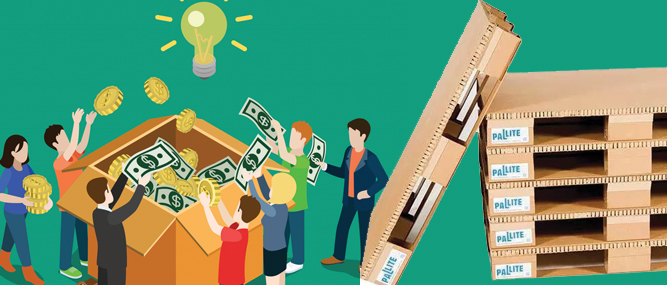Pallite, a paper pallet “up and comer” in the United Kingdom, has recently found itself in the media spotlight. The success of its funding campaign on Crowdcube, a European equity crowdfunding platform, has seen it rake in $1.2 million (£1.058 million) and counting in exchange for 11% of equity. That’s a pretty solid return for a company that generated sales of £1.1 million in 2018 against a loss of £1.7 million.
The campaign is centered around the company’s lightweight hexacomb pallet and its sustainability claims versus plastic or wood. The company’s strong sales growth over the past few years has fueled investor interest. 1H 2019 sales are up 77%, and it boasts blue-chip customers including Kellogs and DHL. Pallite also produces custom corrugated packaging as well as PIX®, an award-winning shelving/storage system.
Upon closer inspection, the pallets, in spite of being at the heart of the campaign, didn’t account for a lot of the growth compared to the other segments. Pallite attributes the relatively modest pallet sales to shifting the focus of its lean marketing resources from pallets to those other opportunities in the short term. Some of the funds will be used to increase its marketing efforts.
Crowdfunding is a way of generating funds through a wide online funnel. Think in terms of a great many investors typically contributing small sums of money. The approach is most popular in the consumer-facing space, where the crowdfunding campaign might offer certain innovative or socially responsible goods or rewards in return for a contribution. Crowdfunding can also support charity fundraising, allowing people to make small contributions toward worthwhile causes.
Equity crowdfunding, on the other hand, is a security-based form of crowdfunding where public shares are issued in exchange for an investment. Such is the case with Pallite. It has received funding from more than 540 investors, with the largest purchase being £200,000. The minimum buy amount is £10 for a single Class A share.
For the fun of it, I began the process of investing 10 quid in Pallite. The first thing you are required to do is to take a quiz, affirming your understanding that:
- Most startups fail
- If they fail you are unlikely to get your money back
- Your investment may not be particularly liquid in terms of getting out
- You shouldn’t anticipate dividends
- Your shares may become diluted if the company issues more shares in the future.
Given that gloomy prognosis, I pondered, “Why are people suddenly opening their wallets to Pallite and its hexacomb deck paper pallet?” After all, hexacomb pallets have been available for many years. I reached out to ask.
“A decade ago, considerations for the environment weren’t as prominent as they are now, and it’s possible that our pitch would not have been as well-received,” commented Matthew Marks, quality manager for Pallite. “However, media such as Blue Planet as well as the recent environmental protests by school children and Greta Thunberg mean that people, and importantly our customers and potential customers now recognize the importance of sustainability. As such, the demand for an eco-friendlier and more sustainable alternative to plastic and wood has never been stronger.”
Novel Ideas with Emotional Attachment Do Well in Crowdfunding
Regardless of how you feel about the environmental claims made by Pallite, the crowdfunding model has shown itself to be a useful funding source for that company. The environmental messaging seemed to play a big part in the campaign’s success, as Marks suggested. Given that investors may not be familiar with paper pallets, it is likely that they are seen as a novel, socially responsible product – just the type of emotional attachment that has found traction in crowdfunding campaigns.
From a financial perspective, the strong recent sales growth of the young company also might spur investor interest. Sometimes strong marketing pitches can lead to investor interest growth beyond true market potential. Although it is not clear if that is the case for this opportunity, one potential investor observed on a discussion board that its 7.7x multiple is higher than that of DS Smith, an industry leader in paper packaging.
What About Wood Pallet Crowdfunding?
The Pallite campaign underscores the increasing importance of sustainability to the public. The good news is that the wood pallet sector has put a lot of work into sustainability messaging through initiatives such as Nature’s Packaging and USDA Biopreferred. If you are a wood products company not as of yet incorporating them into your marketing message, it is time to do so.
As for raising money, would crowdfunding make sense from a wood pallet perspective? It might. Having something new and interesting can make a difference. The element of novelty might be harder to introduce with wood pallets, but you could probably still sell pallet management as a new idea, especially if you had a little different spin on it. Maybe even a new take on recycling might interest an unfamiliar crowdfunding audience.
Crowdfunding might also be an option for a local pallet company that is highly connected to its community. Social media is a big part of a crowdfunding campaign, and if your company has a strong relationship with local people and businesses and needs help, it might work.
As one article notes, “Startup founders have numerous paths to fundraising, from friends and family and angel investors to bank loans and venture capital.” Crowdfunding is a funding option that can allow business owners to bypass conventional channels, enabling them to keep greater control. Ultimately, it’s just one more funding option to consider.




